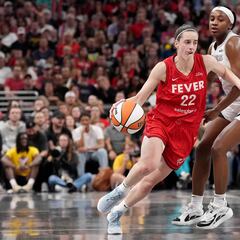What do we know about the bidding war for the next WNBA expansion team?
With ratings at an all-time high, talk of expansion is no surprise. The question is, where will the WNBA’s next team be located, and at what cost? Let’s dive in.


The WNBA is enjoying a boon of success this year and rightly so. With the addition of star rookies like Angel Reese and Caitlin Clark, business is good, which is precisely why there is a veritable bidding war underway for control of the league’s next team.
WNBA has the luxury of choice in expansion
On Wednesday, the WNBA announced that an expansion team was coming to Portland, meaning the league will now have 15 teams. Understandably, that immediately led to speculation about a 16th as that would be required for equilibrium. It wasn’t long before the league confirmed such suspicions, with further reports alluding to the idea that Philadelphia, Nashville, Denver, and South Florida are all being considered with 2028 being the promoted year of entry.
We are thrilled to welcome the @WNBA to Portland, a city renowned for its vibrant sports culture and deep commitment to fostering women's athletics. This expansion marks a significant milestone in our city's sports history and underscores our role as a burgeoning hub for women's… pic.twitter.com/QFKkJUJGRb
— Mayor Ted Wheeler (@tedwheeler) September 18, 2024
Now, whether we talk about the Caitlin Clark effect or the added bonus of her growing rivalry with fellow rookie sensation Angel Reese, the reality remains that there has never been a better time for the WNBA. From record TV ratings which have led to a massive broadcasting rights deal to the general improvement of the level, it’s clear the women’s game is enjoying a period of heightened success. With that in mind, it’s only natural that the possibility of expansion has come to the fore, and with it a number of interested parties who would like a piece of the pie as the price of a new team continues to rise.
Related stories
For context, Portland’s team cost a record $125 million and it’s understood that within a few hours, offers had already doubled that amount. What that means is that the league will soon have some complex choices to make. To what extent will the league limit expansion and if so, on what grounds? If we consider the present situation, one can reasonably assume that should the market be opened, the WNBA could see several expansion teams within just a few years. In such a situation, there is undoubtedly the risk of lowering the level of play.
EXCLUSIVE TO CHRON: Houston Rockets owner Tilman Fertitta plans to submit a bid on a WNBA expansion franchise in the coming weeks, a source with knowledge of the bidding process told Chron 🏀
— Chron (@chron) September 19, 2024
Read more here 👉 https://t.co/CtMUGqpXKr pic.twitter.com/vvwj8g1DFi
Additionally, there is also the threat of a schedule that is exponentially larger such that players are asked to play too many games, a talking point that is becoming more intense across professional sports in general as broadcasting organizations pull more sway. At present, there are 12 teams in the league which has been the case since 2010. Those teams are as of this year playing an expanded 40-game schedule. The Golden State Valkyries are set to join next season, while Toronto and Portland will make their debuts in 2026. Needless to say, the league will face a challenge as it attempts to navigate the immediate need for ticket sales from new franchises. Ultimately, it’s an exciting time for women’s basketball and by the looks of things, that is now set to continue one way or another.


Complete your personal details to comment